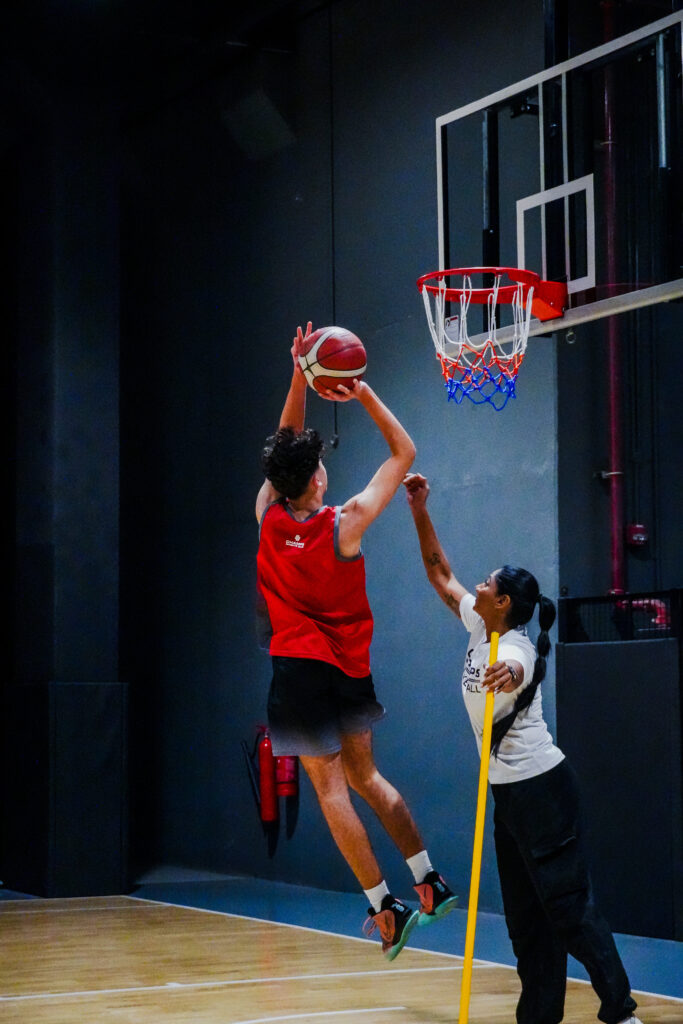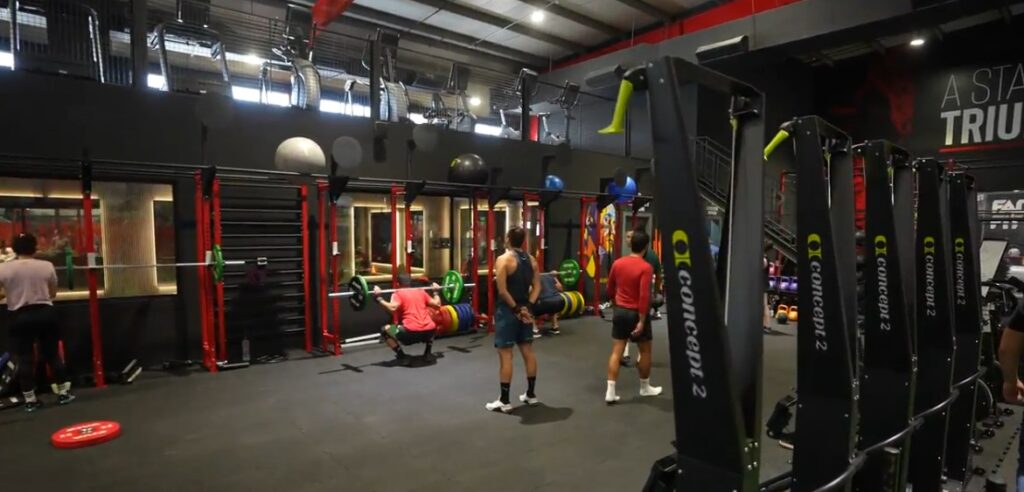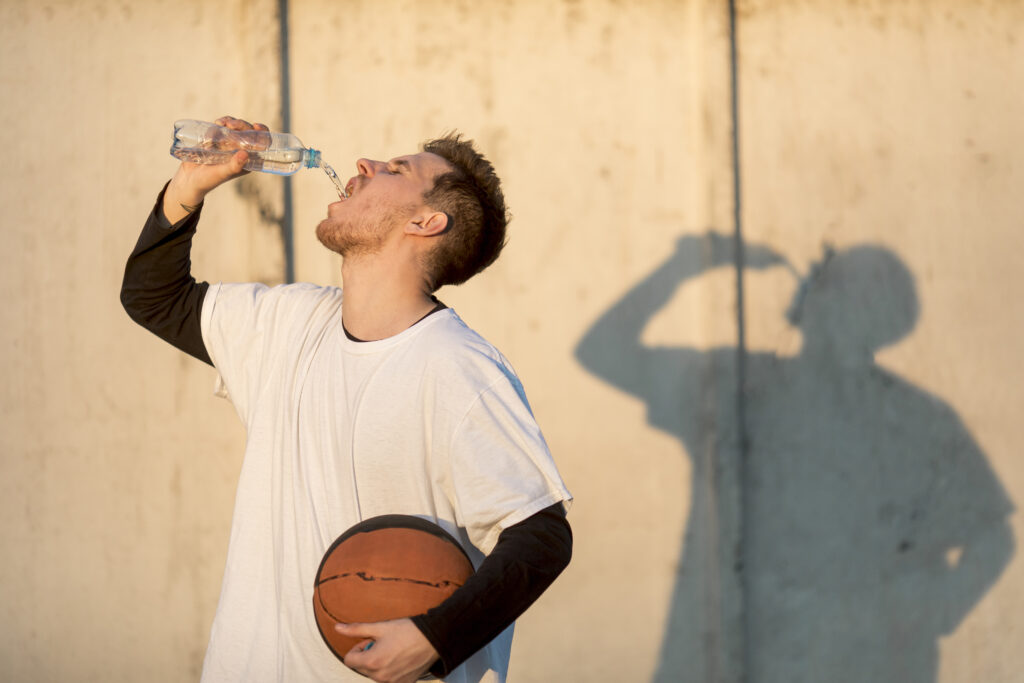Elevating Your Basketball Game
The Athletic Demands of Basketball
Basketball is a dynamic and demanding sport in which you constantly change direction, jump, sprint, and shift your body weight. To keep up with the game’s fast pace, you’ve got to have top-notch athletic abilities, blending explosive strength, sheer speed, and endurance. The twists and turns, sudden sprints, and power jumps you’ll perform are all key moves that require an athletic body to execute.

Why Athleticism Gives You an Edge on the Court
Athleticism, encompassing mobility and robust mechanics, is your secret weapon on the basketball court. It gives you the quick first step to blow past defenders, the explosive power to rise above the rim, and the stamina to maintain peak performance throughout the game. Incorporating a regimen of flexibility and mobility exercises is crucial to boost these abilities, ensuring you retain a full range of motion and prevent injuries. When you’re more athletic, you’re not just a player – you become a force that opponents must reckon with. Focusing on proper landing and stopping mechanics could also significantly reduce the risk of injuries. Your stats improve as you outmanoeuvre, outjump, and outlast the competition. Plus, every aspect of your game, from shooting—where single-handed shooting mechanics are paramount—to passing to defence, can skyrocket simply because your body performs better.
Foundation for Improvement
Proper Sprint Training for Explosive Speed
To achieve explosive speed on the court, proper sprint training is crucial. This isn’t about long, enduring runs—it’s about short bursts of maximum effort. You’ll learn to accelerate quickly through focused sprint drills, reaching your top speed in just a few strides. You’re training your muscles for that same explosive reaction during play by simulating the rapid sprints in a game scenario. Implementing plyometrics and resisted sprinting, like pulling a weighted sled, can help in your acceleration phase, vital for stealing the ball or chasing down a fast break.
Dedicated Footwork – The Key to Agile Movement
If sprinting gives you speed, dedicated footwork training gives you the grace of an elite player—it’s all about being nimble on your feet. Precise footwork is vital for manoeuvring through tight spaces and maintaining balance amidst chaos. Drills using agility ladders and cone patterns are particularly effective in enhancing your footwork. They condition you to make rapid changes in direction and improve coordination. Just picture executing a flawless crossover or sidestepping a defender without breaking stride. That’s the agility you’re aiming for, and with consistent footwork practice, it’s well within your reach.

Strength and Power Development
Targeted Strength Training – Building Basketball Muscles
Targeted strength training hones the specific muscles that you rely on in basketball. Think of your body as a finely tuned machine where every muscle group contributes to your game—quads for squatting power, calves for that jump shot, shoulders and arms for ball handling, and core strength to keep it all together. For instance, squats, lunges, and deadlifts build the lower body strength crucial for explosive jumping and quick sprints. Meanwhile, shoulder presses and plyometric push-ups will bolster your upper body to aid in shooting and rebounding.
Vertical Leap Enhancements – Increase Your Jump Height
Increasing your jump height isn’t just about wow-ing the crowd with dunks; it’s a practical asset for rebounds, blocks, and shots. Vertical leap enhancements come from a combination of plyometric exercises and strength conditioning. Start packing your workout with exercises like box jumps, depth jumps, and renowned stair jumps that build lower body power. These moves focus on quick, explosive power and aim to decrease the time your feet are in contact with the ground. Consistent training coupled with proper jumping technique also minimizes the risk of injury. Remember, the goal isn’t just to jump higher and brighter.
Agility and Flexibility
Mastering Multidirectional Speed
Multidirectional speed is about how swiftly and efficiently you move in all directions, not just forward sprints. Basketball requires lateral quickness for defence, backpedal movements for spacing, and shuffling without crossing feet to maintain a stable stance. To master this, you can perform drills like the lateral shuffle, the defensive slide, and pro-agility drills that recreate the multidirectional demands of an actual game. These exercises improve your ability to accelerate, decelerate, and change directions quickly without losing balance or control, allowing you to react swiftly to any play.
Flexibility Work for Injury Prevention and On-Court Performance
Flexibility is your unsung hero on the court. It aids in extending your range of motion, helps prevent injuries, and can even enhance your shooting form. When your muscles and joints are flexible, you can move with fluidity, reach further, and rebound more effectively. Incorporating dynamic stretching before games and static stretching, post-game encourages muscle recovery and maintains elasticity.
Recovery as a Component of Athletic Training
Understanding the Importance of Rest and Recovery
Rest and recovery aren’t just downtime—they’re when the magic of muscle building and rejuvenation happens. Frequently pushing your body to its limits without ample rest can lead to overtraining and injuries, impeding your performance and progress. It’s essential to listen to your body and give it the time it needs to heal. Designate one to two days a week strictly for rest, letting your muscles repair, and your energy stores replenish. Recovery includes sound sleep, facilitating growth hormone release essential for muscle repair. Treat rest not as inactivity but as an active part of your training regimen where growth and recovery take centre stage.
Nutrition and Hydration Strategies for Athletic Readiness
Nutrition and hydration can’t be underestimated to fuel your game and recovery. They’re the building blocks that support all your training efforts. Your focus on nutrition should revolve around a balanced intake of lean proteins to repair muscles, complex carbohydrates to provide sustained energy, and healthy fats for overall health. Timing your meals is also crucial—ensure you have a meal high in complex carbs and protein at least 2-3 hours before tipoff for sustained energy.
Hydration is another cornerstone. Dehydration can significantly impact your speed, focus, and endurance. Start hydrating well before stepping onto the court and sipping water throughout practice and games. Post-game replenishes fluids and electrolytes lost through sweat.

Measuring Progress and Keeping Motivated
Setting Achievable Goals and Tracking Improvements
Setting achievable goals is the roadmap to your basketball success story. Begin by identifying specific, measurable objectives, such as increasing your vertical jump by 4 inches in three months or improving your free-throw shooting percentage by 10%. This strategy keeps your motivation high and provides clear targets for which to aim. Tracking improvements becomes your daily habit; maintain a training log or use apps to chart your progress through quantifiable data. Witnessing your growth through this recorded feedback is immensely satisfying and propels you towards your next set of goals. Celebrate small victories along the way – the milestones that add to remarkable achievements.
Celebrating Milestones and Staying Focused on Long-Term Growth
Acknowledging milestones is a fabulous way to maintain your drive and passion for the game. These are the tangible results of your hard work, and they deserve recognition. Whether you achieve a personal best in your sprint time or master a complex dribbling sequence, take a moment to savour the success. This celebration helps reinforce positive behaviours and sets a pattern of striving for and reaching new heights.
However, keep sight of the bigger picture. Your basketball journey is a marathon, not a sprint. The key is to stay patient and committed to your long-term development. Keep refining your skills, staying hungry for improvement, and pushing your boundaries. Stay comfortable with your current level of play; there’s always room to grow. Remember, basketball isn’t just about physical strength but mental tenacity. Keeping both in check will ensure you continue to evolve as a player.
